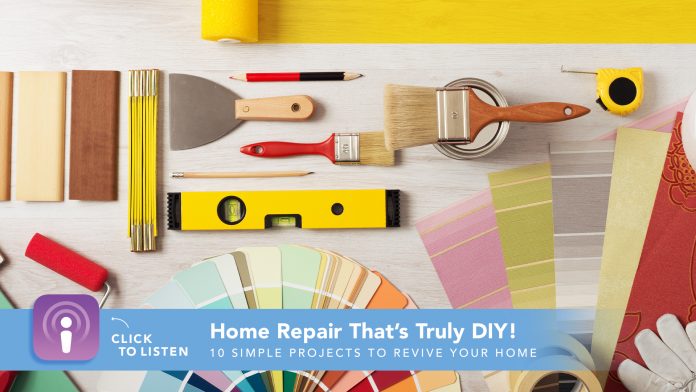As back-to-school season is approaching and it’s still sunny outside, now’s the perfect time to take a stab at some of those do-it-yourself home projects you’ve got on your plate. There are plenty of quick fixes and simple projects you can handle on your own that require few supplies and just an hour or two.
That’s why we’ve gathered a list of easy home repairs that don’t require a professional’s help. So, grab your handy-dandy toolbox and give your home a facelift while staying in budget and not having to set aside a whole weekend!
Listen in to today’s episode of the Gwinnett Podcast as we walk you through 10 simple yet worthwhile home improvement projects to tackle this season!
Today’s show is sort of like our own home fix-it show. It seems like in these warmer months, it’s just a good time to get out and make sure you’re getting those much-needed home projects done.
When something breaks, one of the biggest conundrums for a homeowner is knowing when to dig your heels in and fix it yourself versus realizing when it’s time to call in the pros. So, let’s talk about what you should reasonably expect to be able to repair yourself if you’ve got the time and you’re handy.
Doors and Entryways
One of the simplest aspects of your home is also one of the most important. Maintenance and repair of your doors and entryways are essential requirements, especially on exterior doors which can allow heat or cold air to escape. Is the base scraping the floor? Is the lockset lining up all right? Could be time for a tune up.
Using Caulk
You’ll find caulk everywhere in your home. It’s the sealant used in your tub or sink and around the wall or baseboards. It protects floors and walls from moisture and can keep insects from taking up residence in gaps and cracks around your house. Make your way around your abode with a caulking gun, systematically sealing it.
Unclogging a Toilet
Fun stuff, right? It happens to the best of us, and it’s best to be prepared with some knowledge when disaster strikes. Check first to see if something (like a toy if you have kids) has been dropped into the commode. Next step, try the plunger. Make sure to create a suction seal before you start. Last resorts include plumbing snakes and closet augers.
Patching a Hole
Holes in the wall can be caused by screws, nails and simple human error. Here’s the best thing to do: clean the surrounding area of dirt and debris, then use a putty knife to press spackle into the wall and let it dry. Sand it down with sandpaper until it’s flush with the wall. For bigger holes, you’ll need to apply a drywall patch.
Loosening a Window
During hot or cold seasons, we rarely open the windows around the house. This causes channels in the window to sometimes become clogged with dirt, debris and other stuff that can basically glue the jamb and sash together. Try gently wedging a putty knife between the window frame and the interior trim.
Leaky Faucets
Is the drip, drip, drip driving you nuts? Well, it’s not just you who’s suffering the consequences; your wallet is also feeling the pain. First, shut off the water to the leaking faucet. You can often find a valve nearby it. Find the problem (often, it’s a deteriorated washer), and fix it.
Replacing Broken Tile
It’s bound to happen over time, so why not know how to repair chipped or cracked tiles? You’ll need a grout saw, scoring tool, chisel and safety goggles. From there, it’s a matter of cutting and removing the damaged tiles and adhesive, and placing and setting the new tiles in place.
Removing a Stripped Screw
A pair of locking pliers will usually do the trick. Just turn counterclockwise, twisting, until it comes out. If you still can’t get it out, you can go digging for it with a knife (carefully) or a drill bit. Remember to patch the hole when you’re finished.
Fix a Noisy Bathroom Fan
First and foremost, switch off the circuit breaker that goes to the bathroom. Make sure all electricity is turned off in that room. Oftentimes, the sound you hear is the rattle of a loose cover. Try removing the cover and bend the brackets so they grip better. If that doesn’t work, try vacuuming the unit to quiet the fan blades.
Change Your Filter
It’s not a repair, but it’s important enough to include in this list. Changing the air filter in your heating and air system about once a season can make all the difference in the efficiency of your HVAC. It’s quick and easy.





